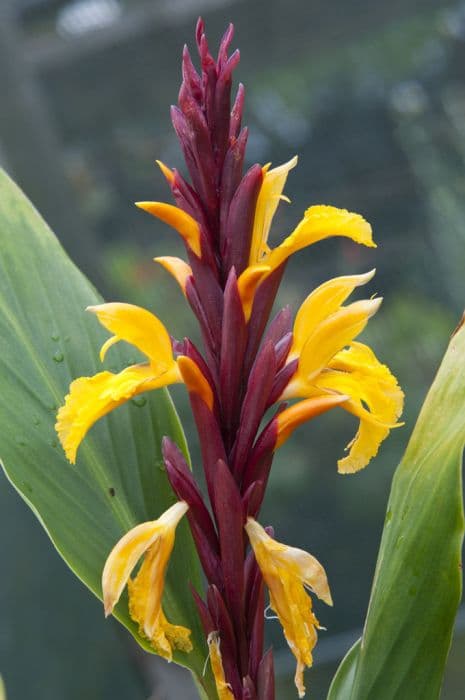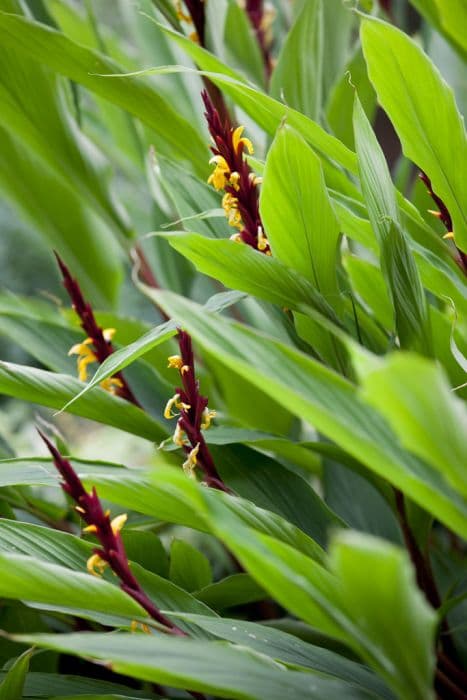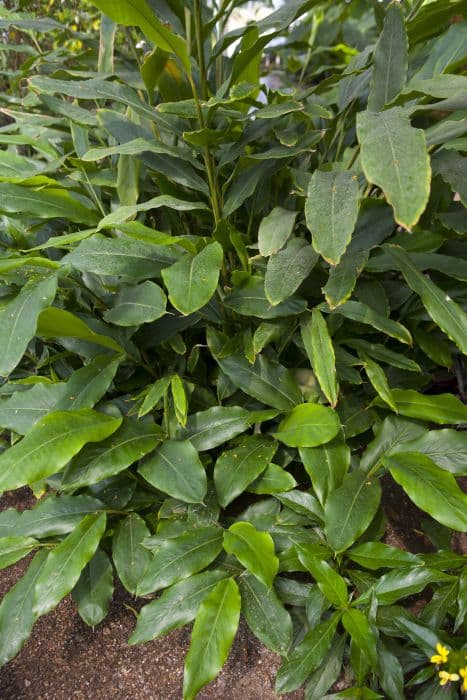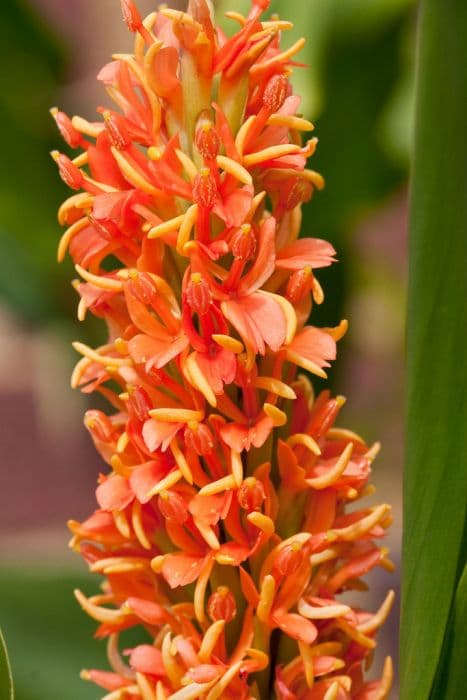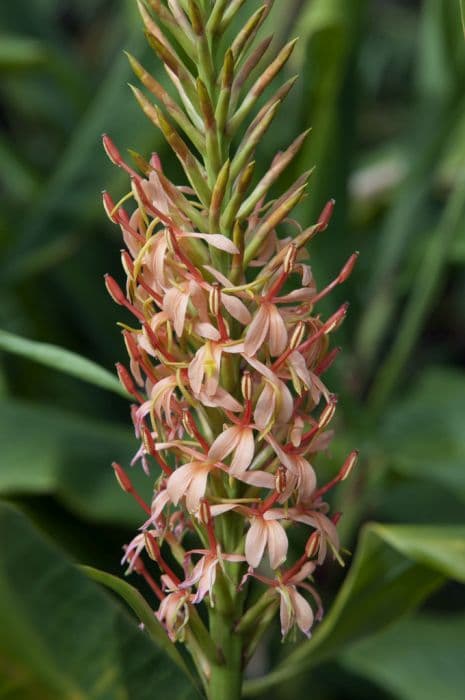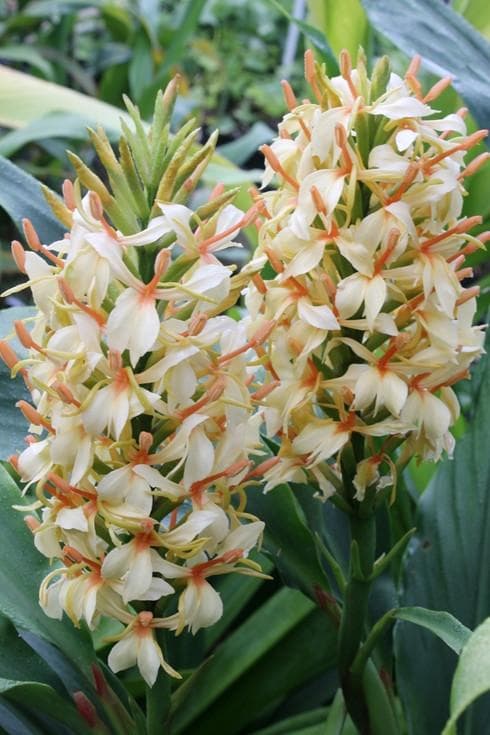Roscoea Beesiana Cream Roscoea × beesiana Cream Group

ABOUT
The Roscoea × beesiana Cream Group, commonly known as Hardy Ginger, presents a striking appearance with its robust and lush foliage. The leaves of this perennial are long and lance-shaped, offering a rich, green backdrop that is both dense and elegant. Unfurling at the base, they form a neat clump with a tropical appeal, although the plant is hardier than its exotic looks might suggest. The flowers are the main attraction, emerging in the warmth of late spring to summer. These blooms are large and orchid-like, held aloft by sturdy stems. The petals are a delicate cream color, sometimes with subtle hints of soft yellow or pale pink. The bloom's lip is often speckled or highlighted with a darker tone, inviting a closer look and enhancing its exotic charm. The color contrast and intricate detail of the blossoms are a magnet for pollinators, humming with bees and butterflies that visit for nectar. This Hardy Ginger's overall form has a clumping habit, making it an attractive addition to the border, where it can provide a lush, tropical touch within a temperate garden setting. Its bold leaves and showy, cream blooms create textural and visual interest, standing out among other perennials. Despite the impressive display, the plant maintains a modest presence, allowing it to be part of mixed plantings without overwhelming its garden companions.
About this plant
 Names
NamesFamily
Zingiberaceae
Synonyms
Roscoea Cream Group
Common names
Roscoea × beesiana Cream Group.
 Toxicity
ToxicityTo humans
There is no widely acknowledged evidence available in the usual horticultural references or scientific literature indicating that Roscoea purpurea, commonly known as Roscoea, is toxic to humans. Thus, it is generally considered to be non-toxic, and there are no specific symptoms of poisoning associated with this plant. Nonetheless, it is always advised that caution be exercised around any plant, as individual sensitivities can vary, and ingestion of plant material not typically meant for consumption is generally not recommended.
To pets
With respect to Roscoea purpurea, commonly referred to as Roscoea, there is no established documentation that suggests this plant is toxic to pets such as dogs and cats. It is generally considered non-toxic, and there are no commonly recognized symptoms of poisoning from ingestion of this particular plant. However, care should be taken as individual pets may have different levels of sensitivity, and ingesting non-food plants can sometimes lead to gastrointestinal upset or an allergic reaction. It is always prudent to keep an eye on pets and prevent them from consuming plants that are not part of their normal diet.
 Characteristics
CharacteristicsLife cycle
Perennials
Foliage type
Deciduous
Color of leaves
Green
Flower color
Cream
Height
1 foot 4 inches (40 cm)
Spread
0 foot 10 inches (25 cm)
Plant type
Herb
Hardiness zones
6
Native area
China
Benefits
 General Benefits
General Benefits- Aesthetic Appeal: Roscoea × beesiana Cream Group, commonly known as Cream Himalayan Ginger, adds a touch of exotic beauty to gardens with its unique, orchid-like flowers and attractive foliage.
- Attracts Pollinators: The plant is known to attract bees and other pollinators to the garden, which is essential for the pollination of many other plants.
- Low Maintenance: Cream Himalayan Ginger typically requires minimal care once established, making it an easy addition to many gardens.
- Shade Tolerance: This plant is well-suited for shadier parts of the garden where other sun-loving plants might not thrive.
- Seasonal Interest: With a bloom time that extends from late spring into summer, it provides visual interest throughout the season.
- Hardiness: It is generally hardy in suitable climates, able to withstand winter temperatures with proper mulching and care.
 Medical Properties
Medical PropertiesThis plant is not used for medical purposes.
 Air-purifying Qualities
Air-purifying QualitiesThis plant is not specifically known for air purifying qualities.
 Other Uses
Other Uses- Roscoea × beesiana Cream Group, commonly known as Hardy Ginger, can be used as a natural dye, where parts of the plant provide hues for textiles.
- Its rhizomes are sometimes used in cooking as a ginger substitute, providing a mild flavor to dishes.
- The flowers can be crystallized and used as edible decorations on desserts due to their delicate appearance.
- Hardy Ginger's robust leaves can be used for crafting or as a natural wrapping material in place of paper or plastic.
- The plant is incorporated into landscaping for educational purposes, demonstrating the evolution of cultivated hybrid plants in gardens.
- Its unique flowering can be a source of inspiration for artists and designers, translating its form into patterns and motifs.
- The plant can be used in floral arrangements and as cut flowers due to their long-lasting and colorful blooms.
- It can serve as a natural pest repellent in gardens, as certain compounds in the plant may deter various garden pests.
- Due to its root structure, the plant can be utilized in erosion control, helping to stabilize soil in sloped gardens.
- Hardy Ginger is used in theme gardens focusing on Asian or tropical themes, providing authenticity and aesthetic appeal.
Interesting Facts
 Feng Shui
Feng ShuiThe Roscoea is not used in Feng Shui practice.
 Zodiac Sign Compitability
Zodiac Sign CompitabilityThe Roscoea is not used in astrology practice.
 Plant Symbolism
Plant Symbolism- Rarity: Roscoea × beesiana Cream Group, commonly known as Hardy Ginger, is relatively rare and exotic, symbolizing uniqueness and preciousness.
- Exotic Beauty: With its striking flowers, Hardy Ginger represents the beauty that is found in the unusual and the exotic.
- Strength and Resilience: As a robust plant that can survive in challenging conditions, Hardy Ginger is often associated with strength and the ability to withstand adversity.
- Surprise and Discovery: The late bloom of Hardy Ginger can signify unexpected beauty and the joy of discovering new wonders.
- Cultural Connection: Hardy Ginger is native to the Himalayas, symbolizing a connection to the cultures and spiritual traditions of that region.
 Water
WaterThe Rose-Stem Roscoea should be watered thoroughly, ensuring that the soil is moist but not waterlogged. It is ideal to water this plant once a week during its growing season, decreasing the frequency to every other week or less during the dormancy period in the winter. A general recommendation would be to apply approximately 1 gallon of water every week in the summer and reduce to 1 gallon every two to three weeks when growth slows down. Always check the top inch of soil for dryness before watering to avoid overwatering, which can lead to root rot.
 Light
LightRose-Stem Roscoea thrives in partial shade where it can receive dappled sunlight. It is best positioned in a spot where it is protected from the harsh midday sun, especially in hotter climates. An east-facing or north-facing garden where the plant can get morning light or late afternoon light is ideal for this plant, ensuring the delicate leaves do not get scorched by intense sunlight.
 Temperature
TemperatureRose-Stem Roscoea prefers a temperate climate, with ideal growing temperatures between 60 and 75 degrees Fahrenheit. It can tolerate temperatures down to about 40 degrees Fahrenheit but should be protected from frost. Hot temperatures above 80 degrees Fahrenheit should be avoided as they may stress the plant.
 Pruning
PruningPrune Rose-Stem Roscoea to remove dead or damaged foliage and to maintain its shape. This is usually done after flowering ends or in the fall as the plant begins to enter dormancy. Cut back the foliage to the base of the stem every year, which encourages fresh growth in the spring. Pruning is generally required once a year.
 Cleaning
CleaningAs needed
 Soil
SoilThe Roscoea, also known as Hardy Ginger, prefers well-draining, humus-rich soil with a slightly acidic to neutral pH of around 6.5 to 7.2. A good soil mix can be made by combining loam, peat, and sharp sand or perlite to ensure adequate drainage.
 Repotting
RepottingHardy Ginger should be repotted every 2 to 3 years to refresh the soil and accommodate growth. Repotting is ideally done in the spring as the plant emerges from dormancy.
 Humidity & Misting
Humidity & MistingHardy Ginger thrives in moderate to high humidity levels, ideally between 50% to 70%. This plant does not tolerate dry air well and benefits from a moist environment.
 Suitable locations
Suitable locationsIndoor
For Hardy Ginger, provide bright indirect light and maintain even moisture.
Outdoor
Plant Hardy Ginger in partial shade in well-draining soil.
Hardiness zone
6-9 USDA
 Life cycle
Life cycleThe life of Roscoea × beesiana Cream Group, commonly known as Roscoea, begins with seed germination in moist soil conditions, often occurring in late winter or early spring under temperature-controlled cultivation or in its natural habitat when conditions are suitable. Upon germination, seedlings emerge and develop into juvenile plants, forming a rosette of leaves close to the ground. As the plant matures, it forms a more robust root system and sends up taller leafy shoots, preparing for the flowering stage which typically occurs in summer. The flowering stage is characterized by the emergence of cream-colored flowers that attract pollinators and can lead to cross-pollination. After pollination, the plant forms seed capsules, and once the seeds mature, the plant reaches the end of its annual growth cycle, and the aerial parts die back to the ground; the plant then overwinters as a dormant rhizome. With the next growing season, the cycle begins anew, with the rhizome sending up new growth to repeat the process.
 Propogation
PropogationPropogation time
Spring to early summer
The most popular method of propagating Roscoea × beesiana Cream Group, also known as Roscoea, is through division. This is usually done in late winter to early spring, just before new growth begins. The clump of the plant should be lifted carefully from the ground and any soil sticking to the roots should be gently removed. Then, using hands or a sharp knife, the clump is divided into smaller sections, making sure that each new piece has at least one growth bud. These sections are then planted immediately at the same depth they were growing before, in well-drained soil, and watered thoroughly. It's important to keep the newly planted divisions well-watered until they are established, especially during their first growing season to ensure successful establishment.
